In Memoriam
Thomas E. Lovejoy III
Tom Lovejoy died on Christmas Day, 2021. Although he graduated with our Class, he chose to be affiliated with the Class of ’63. Here are the following:
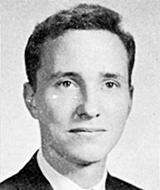
Tom Lovejoy
1964 graduation
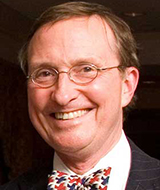
Tom Lovejoy
with his trademark bow tie
- Obituary, The New York Times
- Obituary, The Washington Post
- Commentary, The New Yorker
- Remembrance, Yale School of the Environment
- Remembrance, Center for Humans & Nature
- Remembrance by Jim Currie, Class of ’64
- Essay by Tom in our 50th Reunion Class Book

Obituary, The New York Times
Thomas Lovejoy, Wide-Ranging Ecologist and Amazon Rescuer, Dies at 80
His ambitious, long-running project in Brazil explored the impact of deforestation on animals and plants — and how to deal with it.
The New York Times
December 28, 2021
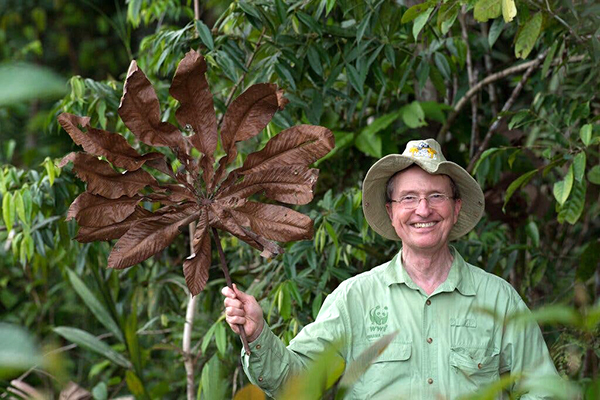
Thomas Lovejoy in 2014. The centerpiece of his career in ecology was research
in the Amazon, but he also published an early projection of extinction rates, conceived
the public television series “Nature” and popularized the term “biological diversity.”
Thomas Lovejoy, a prominent biologist for major conservation groups who spent decades on an expansive, ongoing project in Brazil to preserve the Amazon rain forest, died on Saturday at his home in McLean, Va. He was 80.
The cause was pancreatic neuroendocrine tumors, his daughter Elizabeth Lovejoy said.
Dr. Lovejoy “was a historic figure,” said Russell Mittermeier, the chief conservation officer of Re:wild, a conservation organization.
“He really put the Amazon, and in particular Amazonia, on the international conservation map,” Dr. Mittermeier added, referring to the vast area of rain forests on South America. “When the whole conservation business started in the ’60s and ’70s, there was little focus on South America. But Tom changed that.”
Dr. Lovejoy’s field research in the Amazon was the centerpiece of a broad career dedicated to ecology. He invented “debt for nature” swaps, which let countries trade forgiveness of a portion of their foreign debt for their investments in conservation. He published an early projection of extinction rates, was a creator of the public television series “Nature,” and popularized the term “biological diversity,” later shortened to biodiversity.
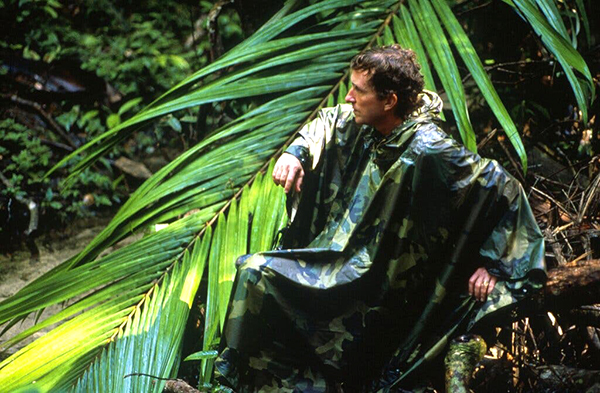
Dr. Lovejoy in the Amazonian rain forest of Brazil in 1989. He sounded
the alarm against its erosion as a source of global warming.
Dr. Lovejoy long ago called for the preservation of biologically diverse ecosystems that store carbon to help fight climate change, but deforestation has continued to erode Amazonian rain forests. In an essay last month in The New York Times, he and John Reid, an economist who helps Indigenous peoples protect their territories, wrote: “Forests continue to disappear — cut and burned into ever smaller patches. This failure challenges all of our climate efforts because unless forests remain standing, the world will never contain global warming.”
Dr. Lovejoy spent more than 40 years on his ecological work in the Amazon. Since 1979, his Biological Dynamics of Forest Fragments Project has tested whether birds, mammals, insects, and trees survive in patches of rain forest cut off by roads, development, or agriculture. Dr. Lovejoy and his team documented the species in parcels ranging in size from one to 100 hectares near Manaus, Brazil, to see if they could survive being cut off from intact larger forests, and what happens to those exposed to heat on the perimeters of the land.
Some rodents, certain frogs, and light-loving butterflies were found to have survived well in the fragments but mammals and some birds with large ranges suffered, according to an article in 2011 in Mongabay, a nonprofit environmental science and conservation news website.
“Fragments lose up to 30 percent of their biomass, essentially forever, because of the vulnerability of big trees to windthrow,” Dr. Lovejoy told Mongabay, referring to the felling or breaking of trees by wind. He added, “Hundred-hectare fragments lose half of the forest interior bird species in less than 15 years.”
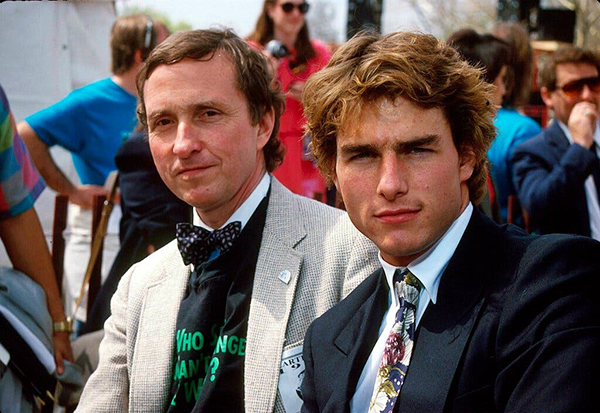 Dr. Lovejoy with Tom Cruise in 1990.
Dr. Lovejoy with Tom Cruise in 1990.He sought to enlist boldface names in his campaign to save the rain forest.
Dr. Lovejoy set up a research facility, Camp 41, near Manaus, for scientists attracted by the allure of the immense tropical wilderness. Its tin-roofed structures are the base not only for working ecologists but also for the prominent people Dr. Lovejoy invited to witness the deforestation and to recruit as potential allies in preservation. They included donors, politicians (Senators John Heinz, Tim Wirth, and Bill Bradley), celebrities (Tom Cruise, Olivia Newton-John, and the novelist Peter Benchley) and media elite (the newsmen Tom Brokaw, Ben Bradlee, and Walter Cronkite).
“We went to his site, clambered over miles of tree trunks, spent time in the forest with jaguars, ate dry cheese and water for dinner, and slept in hammocks,” Paul R. Ehrlich, professor emeritus of population studies at Stanford University and the author of The Population Bomb (1968), said in a phone interview.
In a statement after Dr. Lovejoy’s death, Mr. Wirth recalled exploring the rain forest by day and sleeping to “the sounds of howler monkeys and the snoring of Al Gore, Jack Heinz, Ben Bradlee, and Peter Benchley, packed together side by side, bumping up against each other in swinging hammocks.”
Dr. Lovejoy was known as a charming host and created a congenial atmosphere for his guests in the Amazon, but his intentions were deadly serious. If more deforestation occurs, the impact on the rain forest’s hydrological cycle — and the planet — would be dire, he warned.
“It’s really part of the continental climate system,” he told The Christian Science Monitor in 2018. “And that’s not a very sensible thing to mess around with.”
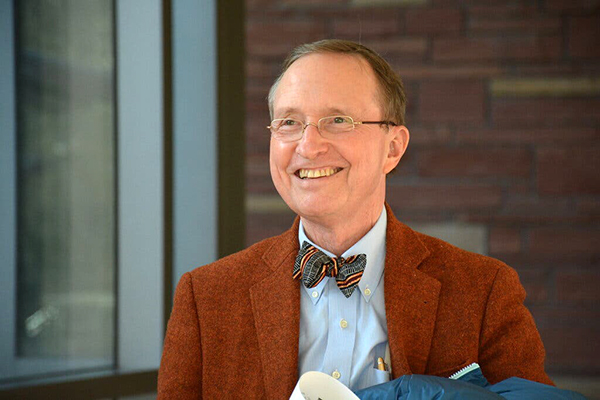
“Hundreds of thousands of species,” Dr. Lovejoy once wrote,
“will be irretrievably lost as their habitats vanish, especially in tropical forests.”
Thomas Eugene Lovejoy III was born on Aug. 22, 1941, in Manhattan. His father, Thomas Jr., was the president of the Manhattan Life Insurance Company (as was his grandfather, who in 1912 led a group that acquired control of it), and his mother, Jeanne (Gillette) Lovejoy, was a homemaker. (As an adult, Dr. Lovejoy would serve as a director and chairman of Manhattan Life.)
An only child, he loved the outdoors and reading (his family did not have a television). He attended the Millbrook School in Dutchess County, N.Y., about 90 miles north of Manhattan, because it had a zoo that nurtured what he called the “beautiful and intellectual attraction” of living things.
He studied biology at Yale, where he was a zoological assistant at the Peabody Museum of Natural History. He took a year off to study in the Nile River region of Nubia, and graduated with a bachelor’s degree in 1964. While working toward his Ph.D in biology at Yale, he spent a summer studying migratory birds in the Amazon; his dissertation was on the diversity of birds in the rain forest.
“The Amazon basin at the time was a mostly trackless virgin forest,” Dr. Lovejoy said in an interview in 2012 when he received the Blue Planet Prize from the Asahi Glass Foundation for his environmental research. “It was like a dream world for any biologist because there was only one road in the entire area, which had a population of three million.”
Much of his research in the Amazon occurred while he held positions at four organizations, all of which understood that he would need time for his research and would not be a full-time employee. He spent 14 years at the World Wildlife Fund in the United States (he was its 13th employee), rising to executive vice president from 1985 to 1987, and was the assistant secretary for environmental and external affairs at the Smithsonian Institution from 1987 to 1994. He was a senior scientist when he left the Smithsonian in 2001.
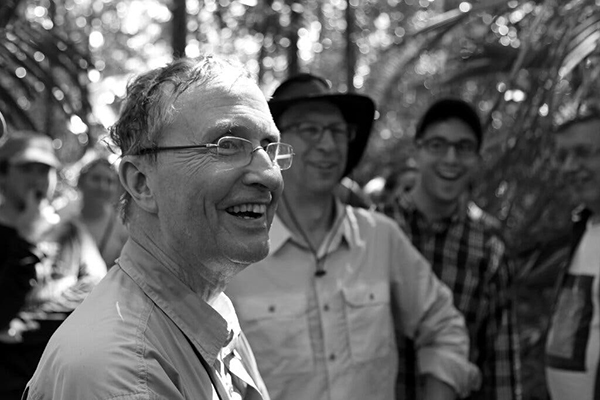
Dr. Lovejoy in 2017 at his research center, Camp 41, near Manaus, Brazil.
At the World Bank, he was the chief biodiversity officer from 1999 to 2002. At the H. John Heinz III Center for Science, Economics and the Environment, he was president and, later, the biodiversity chair, from 2002 to 2013.
During his time at the World Wildlife Fund, he wrote a section of a report commissioned by President Jimmy Carter — “Global 2000: Entering the 21st Century,” released in 1980 — in which he projected that 20 percent of all species on earth would be extinct by 2020.
“Hundreds of thousands of species,” he wrote, “will be irretrievably lost as their habitats vanish, especially in tropical forests.” Looking back 32 years later in the Blue Planet interview, he said, “My projection was not far from the mark.”
He later wrote two papers using a new term: “biological diversity.”
In 1984, he proposed the debt-for-nature swaps as a mechanism to keep developing countries from having to slash their conservation budgets to pay off debt. Such swaps, he wrote in an opinion column for The Times, “would be far more than a disinterested handout to mendicants: Left untouched, the environmental problems of the third world inevitably will touch our lives by generating social and political unrest.”
In addition to his field research and executive positions, Dr. Lovejoy served on scientific advisory councils in the administrations of Presidents Ronald Reagan, George H.W. Bush, and Bill Clinton. In 2010, he became a professor in George Mason University’s department of environmental science and policy, teaching a course in the challenge of biodiversity.
In addition to his daughter Elizabeth, known as Betsy, he is survived by two other daughters, Katherine Petty and Anne Jenkins, and six grandchildren. His marriage to Charlotte Seymour ended in divorce.
Camp 41 was not the only site that Dr. Lovejoy used to bring disparate people together; he also hosted them at his home in McLean, a log cabin called Drover’s Rest, for dinners and fine wine.
“There was always an element of a higher purpose” at such gatherings, said Jane Lobchenco, a marine ecologist who is deputy director for climate and environment in the White House’s office of science and technology policy. “He brought people together to build connections in a way that might lead to more conservation action.”

Obituary, The Washington Post
Thomas E. Lovejoy III, an ecologist who dedicated his career to preserving the Amazon rainforest, dies at 80
The Washington Post
December 27, 2021
Thomas E. Lovejoy III, an ecologist who dedicated his career to preserving the Amazon rainforest and educating Washington policymakers and the public about the dangers of climate change, died Dec. 25 at his home in McLean, Va. He was 80.
His daughter Elizabeth Lovejoy said he died of pancreatic cancer.
Dr. Lovejoy was considered one of the most consequential conservation biologists of his generation for his ability to meld field research — on how fragmented forests deplete diversity and how they can store carbon if protected — with environmental and policy work to draw attention to the plight of the Amazon, the world’s largest and most diverse rainforest.
Among his many innovations, he introduced the term “biological diversity” in 1980; he made the first projection of global extinction rates in a report to President Jimmy Carter; and he devised the concept of “debt-for-nature swaps,” in which part of a country’s foreign debt is forgiven in exchange for investments in conservation.
Throughout the course of Dr. Lovejoy’s career, much of it based in the Washington area for organizations such as the Smithsonian Institution, the World Wildlife Fund, and George Mason University, he became increasingly alarmed about climate change and the global extinction crisis. In spreading this message, he allied with lawmakers and Hollywood celebrities, often leading them on tours of his research station north of Manaus, the capital of the Brazilian state of Amazonas, known as Camp 41.
“I count myself lucky to have had the great privilege of staying there several times, learned the proper way to sleep in a hammock, identify the source of the loudest snoring, and I always came away inspired and connected to the Brazilian Amazon in the deepest way,” Carter Roberts, president and CEO of the World Wildlife Fund in the United States, said in a statement, describing Lovejoy as “truly a legend” whose “impact will be felt for decades to come.”
With his pince-nez glasses and vast bow-tie collection, Dr. Lovejoy was also a fixture in Washington, testifying on Capitol Hill, meeting with journalists, and hosting senators and scientists for dinners at Drover’s Rest, his historic log cabin in McLean, filled with books and curiosities from the natural world. Despite the severity of the forest destruction in the Amazon and elsewhere, and the grave projections of the warming world, he maintained a sense of optimism that humans could find ways to change course and avert the worst outcomes.
Even in late 2019, when he and longtime colleague Carlos Nobre of the University of São Paulo wrote that clear-cutting, rising temperatures, and wildfires were pushing the Amazon to a tipping point where it was “teetering on the edge of functional destruction and, with it, so are we,” he held out a sliver of hope.
“In this case, it’s not going to be instantaneous, and that’s good news,” he told The Washington Post at the time. “It allows you to do something about it.”
Thomas Eugene Lovejoy was born in New York City on Aug. 22, 1941. He was an only child and grew up in a privileged setting on the Upper East Side. Both his father and grandfather had been chief executives of the Manhattan Life Insurance Co.
Dr. Lovejoy told The Post he chose his boarding school, the Millbrook School in Dutchess County, N.Y., because it had a zoo. He said the school’s founder, Frank Trevor, inspired him to study biology, particularly birds, and “awakened me to the fascination of nature and biology.”
He received a bachelor’s degree in biology in 1964 from Yale University and stayed at Yale to complete his PhD, also in biology, in 1971.
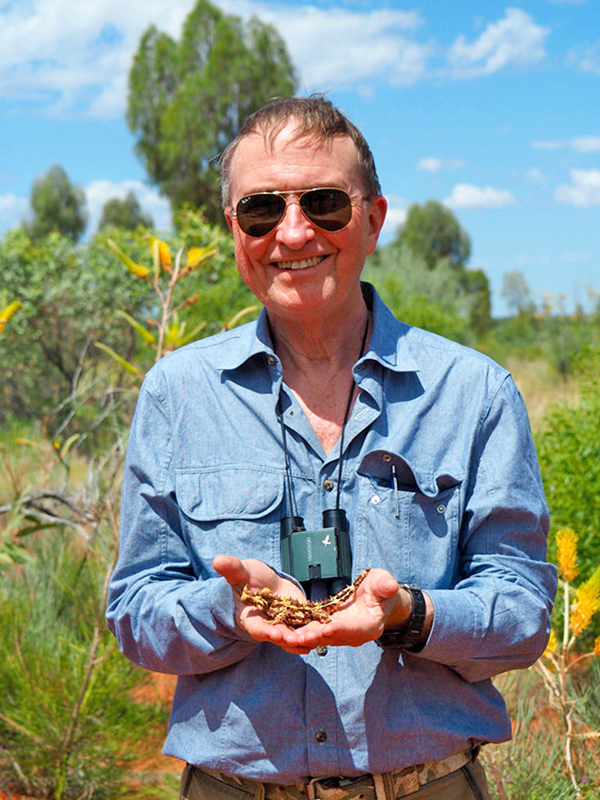
Thomas Lovejoy, a conservation biologist credited with coining the term “biological diversity,”
holds a Thorny Devil in Australia in September 2016.
In the summer of 1965 while in graduate school, Dr. Lovejoy got a chance to visit the Brazilian Amazon while working with the Evandro Chagas Institute in the forest outside Belém, a trip that persuaded him to do his doctoral dissertation there on the ecology of birds.
“I’ve always been fascinated with biological diversity, and imagined having a life full of scientific adventures — and the Amazon was this incredible, tropical wilderness,” he told a Brazilian magazine in 2015, after a half-century visiting the country. “So it was like I had died and gone to heaven. It was sheer fascination, and I gradually began to move from just doing science to doing science and environmental conservation. The Amazon is one of the most important places to work in the world.”
The Biological Dynamics of Forest Fragments Project, which Dr. Lovejoy launched in 1979 with the support of Brazil’s National Institute of Amazonian Research and the Smithsonian, is one of the world’s biggest — and longest-running — biological ecosystem experiments. Consisting of differently sized plots of Amazon rainforest near Manaus, the research project has cast light on the importance of “edge effects” on forests that are disturbed by humans, either from the creation of roads and infrastructure or from outright deforestation. The research found that when forest edges are created, the remaining areas of rainforest most closely exposed to them become hotter and drier and lose carbon, and the diversity of species within them declines.
Near the test forest plots, in a cool expanse of intact rainforest, lies Camp 41, which for some nonscientists may be even more famous than the research project with which it was associated. A humble site with screened hammocks for beds and natural river baths, it was a place where Dr. Lovejoy brought many policymakers and other influential people to visit the rainforest in its undisturbed state. For some, the experience included encountering the majestic harpy eagle, one of the world’s most powerful avian predators and a threatened species that has been known to nest near the camp.
As a consequence, conservationists and governments sought to create protected areas and understand the effect of development. Nobre, one of his collaborators on other research in Brazil, said that many of the cattle farms where Dr. Lovejoy focused his research are now abandoned, allowing scientists to study how forests regenerate and which species return.
Dozens of politicians and celebrities, including Al Gore and Olivia Newton-John, made the trip into the jungle to visit Camp 41. Tom Cruise nicknamed Dr. Lovejoy “Indy,” after Indiana Jones, following a trip to the camp. Family members recalled his love of practical jokes, including planting fake tarantulas in hammocks.
Former senator Timothy E. Wirth (D-Colo.), president emeritus of the United Nations Foundation, was a close friend who traveled with Dr. Lovejoy to the Arctic and the South Pole, rafted through the Grand Canyon, and explored deep into the Amazon.
“He was incredibly warm and mischievous, as well as being a first-rate scientist,” Wirth said in an interview. “Nobody more fun to be with.”
On one congressional delegation visit to the Amazon, after the 1988 assassination of Brazilian rubber tapper and environmentalist Chico Mendes, Wirth recalled that the Brazilian government suspected the U.S. senators were investigating Mendes’s death and sent police to keep watch.
“Serge-suited goons followed us all over the Amazon, sweating like crazy,” Wirth said.
Before meeting Dr. Lovejoy, Ben Bradlee, former executive editor of The Washington Post, had been somewhat skeptical of environmental concerns, according to his wife, Sally Quinn.
“He used to say, ‘Don’t tell me that every time I squirt an underarm deodorant it’s going to penetrate the ozone layer,’ ” Quinn recalled.
But after his visit to the Amazon in 1988 with Dr. Lovejoy — and laughing about the infamous candiru, an Amazonian fish supposedly capable of swimming up a man’s urethra — Bradlee returned a convert.
“He said, ‘Well, I guess I’ve become a f---ing tree hugger,’ ” Quinn said. Bradlee assigned “somebody to cover the environment and he got with the program.”
As for Dr. Lovejoy, Quinn described him as a Renaissance man, knowledgeable about politics, literature, food and wine, in addition to science.
“Everybody loved him, he was so aptly named,” she said. “He was really lovely, he was a wonderful person, and joyous.”
Dr. Lovejoy also worked for the World Bank, the United Nations Foundation, and the Heinz Center for Science, Economics & Environment and was affiliated with numerous environmental and academic institutions. He had held the title of university professor at George Mason since 2010. He was a major contributor to the Amazon Assessment Report, presented at the United Nations climate conference in Glasgow, Scotland, in November.
His marriage to Charlotte Seymour ended in divorce. Survivors include three daughters — Katherine L. Petty of Telluride, Colo., Elizabeth P. Lovejoy of Washington, Anne L. Jenkins of Arlington, Va. — and six grandchildren.

Daily Comment, The New Yorker
December 28, 2021
Honoring the Legacy of E. O. Wilson and Tom Lovejoy
The two naturalists helped to pioneer the field of conservation biology and remained determinedly hopeful that humanity would make better choices.
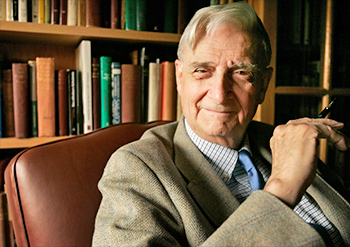
E. O. Wilson
Over the weekend, two of the country’s leading naturalists, E. O. Wilson and Tom Lovejoy, died a day apart. Wilson, who was perhaps best known for his work on ants, was a pioneer in the field of conservation biology; Lovejoy was one of the founders of the field. The two men were friends — part of an informal network that Wilson jokingly referred to as the “rain-forest mafia” — and there was something eerie about their nearly synchronous passing. “I’m trying very hard not to imagine a greater planetary message in the loss of these biodiversity pioneers right now,” Joel Clement, a senior fellow at the Harvard Kennedy School’s Belfer Center for Science and International Affairs, tweeted on Monday.
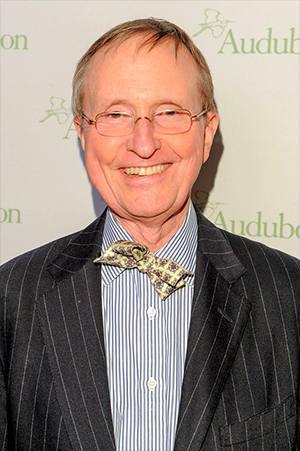
Tom Lovejoy
The two scientists first met in the mid-nineteen-seventies. At that point, Wilson was in his mid-forties, and teaching biology at Harvard. Lovejoy, a dozen years younger, was working for the World Wildlife Fund. Over lunch, they got to talking about where the W.W.F. should focus its efforts. They agreed that it should be in the tropics, because the tropics are where most species actually live. There wasn’t a good term for what they were trying to preserve, so they tossed one around — “biological diversity” — and put it into circulation. “People just started using it,” Lovejoy recalled, in an interview in 2015. (Later, the phrase would be shortened to “biodiversity.”)
In the seventies, Wilson and Lovejoy were both already deeply concerned about what was happening to the tropics. Increasingly, rain forests were being felled to make room for roads, farms, and logging operations. A decade earlier, Wilson, together with a Princeton professor named Robert H. MacArthur, had published a slim volume called The Theory of Island Biogeography. Though the book concerned actual islands, surrounded by water, its implications seemed to extend to isolated habitats, surrounded by human development. According to Wilson and MacArthur’s theory, the smaller these “islands,” the fewer species they would retain.
Caption: Tom Lovejoy spent most of the past forty years trying to preserve the Amazon rain forest.Photograph by Lev Radin / Shutterstock
The volume was published while Lovejoy was doing Ph.D. work on birds in the Amazon. Around the time that he and Wilson first met, he came up with an idea about how to test the theory. The Brazilian government was encouraging people to settle north of Manaus. The government would pay for ranchers to move to the area, cut down the rain forest, and start raising cattle. At the same time, it required that ranchers leave half of the forest on their land intact. Lovejoy proposed that the ranchers coöperate with scientists to create different-sized patches of rain forest that could then be studied. The experiment became known as the Biological Dynamics of Forest Fragments Project, or the B.D.F.F.P., and it continues to this day. It has shown that small fragments of forests lose species, and then just keep on losing them.
Lovejoy spent most of the past forty years trying to preserve the Amazon. He took anyone he thought could help with this effort to visit the B.D.F.F.P., including several American politicians and also Tom Cruise. (When I visited the B.D.F.F.P., in 2012, Lovejoy told me that Cruise had seemed to enjoy himself on the trip but had never seriously taken up the cause.) In his writings, Wilson, too, campaigned for the preservation of the Amazon, and of tropical forests in general. In one of his last books, Half-Earth: Our Planet’s Fight for Life, he called for setting aside half of the world’s surface as untouchable. “The only hope for the species still living is a human effort commensurate with the magnitude of the problem,” he wrote.
By most objective measures, it is discouraging to work in conservation biology these days. Human impacts on the planet continue to grow and, as they do, the space available for other species continues to shrink. In the Amazon, deforestation rates started to slow around 2010, but in recent years they have been ticking up again. In 2019, Lovejoy and a Brazilian scientist, Carlos Nobre, warned that the region was nearing a critical threshold. The Amazon rain forest is so huge that it creates its own weather patterns. If deforestation continued, the pair cautioned, then the rains that made it a rain forest would eventually stop falling. “The precious Amazon is teetering on the edge of functional destruction and, with it, so are we,” they wrote.
Despite it all, though, Lovejoy and Wilson remained determinedly hopeful. There was still time to save, if not the entire Amazon, then most of it; if not every species, then the great majority. Lovejoy liked to say that optimism was “the only option.” He advocated a vast program of reforestation on lands like those around the B.D.F.F.P., which ranchers abandoned after a few decades. “I believe we will choose wisely,” Wilson wrote toward the end of The Future of Life, published in 2002. The only way to really honor his and Lovejoy’s legacy would be to prove him right.
Remembrance, Yale School of the Environment
YSE Mourns Conservationist Thomas Lovejoy: “An Amazing Role Model”
January 13, 2022
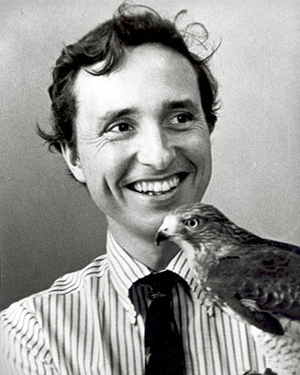
The YSE community is mourning the loss of renowned conservation biologist Thomas E. Lovejoy ’63 BA, ’71 PhD. A senior fellow at the United Nations Foundation, Lovejoy’s decades-long field research on the Amazon, invention of “debt for nature” swaps, promotion of the term “biological diversity,” and commitment to calling attention to extinction rates put him at the forefront of some of the most important issues facing humanity in the 20th and 21st centuries. Lovejoy, who created the public television series “Nature,” called the world’s attention to the dire impacts of the fragmentation of forests and the need to preserve forests and wildlife and ecosystems that store carbon. Lovejoy studied biology at Yale and was an assistant at Yale’s Peabody Museum of Natural History, an advisory board member for the Yale Institute for Biospheric Studies, and a longtime member of the YSE Leadership Council.
He served as a chief biodiversity advisor for the environment for the World Bank, an assistant secretary at the Smithsonian Institute, and executive vice president of the World Wildlife Fund. He died in December at his home in Virginia.
“Tom was an amazing role model. He was a scholar with real-world impact in not only advancing — even creating — a field, but also working in complex diplomacy with governments to advance conservation and reduce deforestation,’’ said Dean Indy Burke. “He believed with all his heart that each of us could make a difference with our science and with our diplomatic and empathetic advocacy. He was an eternal optimist despite what he witnessed. I’ll always remember his elvish smile.”
Oastler Professor of Population and Community Ecology at YSE Os Schmitz said that while Lovejoy’s research findings were sobering, he was never discouraged.
“Tom Lovejoy was that rare breed of scientist that had multifaceted capabilities. He not only had the capacity for deep technical scientific thinking and analysis, but also the ability to step back and distill that technical knowledge in ways that helped solve environmental problems,” Schmitz said. “He was a genuine and caring colleague, and an excellent mentor to young scientists aspiring to assume their own careers at the nexus of scientific research and application. He made our world a better place in which to live.’’
Below, Alexander Brash ’85 MFS, pays tribute to his lifelong friend and colleague.
I first met Thomas Lovejoy when I interviewed for a job with him in late 1980, having been introduced by another long-time NYC Linnaean Society member, Roger Pasquier. Like Tom I was a native New Yorker and had fallen in love with birds at Jamaica Bay and Central Park. We both chuckled on meeting as we realized we were wearing identical blue Brooks Brothers’ suits. First impressions count, and I was hired.
Tom transcended his ornithological interests to become one of the most noted conservationists of our times. He became interested in birds as a child, but when he went to Millbrook School in New York, near the Hudson River, his broader intellectual curiosity in the biotic world was sparked. After Millbrook he went to Yale and worked at the Peabody Museum. He wandered off for a year to study birds along the Nile. After graduating in 1964, he stayed to continue his studies. He visited the Amazon to research avian migrants and fell in love with its magnificent flora and fauna. He then focused on the resident avian species and pioneered mist-netting in the Amazon’s forest canopy. He received his PhD from Yale in 1971 after delving into the mathematics of diversity. At Yale Tom also became quite close to Professor G. Evelyn Hutchinson who is widely regarded as the father of modern ecology. Hutchinson built on Charles Elton's idea of an ecological niche, further refining it as "a highly abstract multi-dimensional hyperspace” and was also one of the first proponents of the notion that an increase in carbon dioxide would lead to a global temperature increase.
Over the past five decades Thomas Lovejoy has helped bring global attention to the Amazonian rainforest and the threats it faces, leading seminal research that has become the foundation of the field of conservation biology — even coining the term “biological diversity.”
After earning his PhD, Tom moved to Washington, D.C. to work in conservation. Throughout his career Tom was a major proponent of three key issues that he brought to the world’s attention: biological diversity, the dire consequences resulting from tropical deforestation, and climate change. He coined the term biological diversity, which he shortened to biodiversity.
He became vice president of science at the World Wildlife Fund – U.S., where he provided scientific reviews and recommendations on projects up for funding. Among many others, Tom ardently supported Russell Mittermeier’s work on primates and Anne LaBastille’s efforts to protect and restore the Lake Atitlan Grebe. While at WWF, Tom started his incredibly ambitious Minimum Critical Size of Ecosystems project, perhaps the largest study ever of forest fragmentation. He worked with the Brazilian government and local ranchers near Manaus to preserve forest plots of one, ten, and one hundred hectares which were isolated by surrounding grazing area. He simultaneously raised funds to bring a host of scientists and students to the region and helped train a generation of Brazilian biologists.
Tom wrote tirelessly and spoke frequently; through his career he edited ten books and authored or co-authored 321 papers, and was the consummate conservation host in D.C. Nearly every week, when he was not in Brazil or otherwise traveling, Tom would pull together splendid but low-key dinners for visiting scientists at his home, called Drover’s Rest, in McLean, Virginia. E.O. Wilson, Paul Ehrlich, Jared Diamond, George Woodwell, Jane Lubchenco, and many others were his guests. Indeed, it was late one night in the early 1980s when Tom’s attention to climate change was re-ignited. George Woodwell, founder of the Woodwell Climate Research Center (formerly known as the Woods Hole Research Center) shared a graph of rising global atmospheric carbon levels. Recollecting Evelyn’s work, Tom soon began promoting an awareness of the ecological consequences.
Tom was a great admirer and close friend of Yale Professor and ornithologist Dillon Ripley, who later served as secretary of the Smithsonian Institute. After WWF, Tom served also worked there, serving as assistant secretary for the environment from 1987-1994. In 2002, he became president of the H. John Heinz Center for Science, Economics, and the Environment. In recent years he was a professor at George Mason University, lecturing on biodiversity.
Tom remained an inveterate Yalie all his life. He became closely involved with the Yale School of the Environment and later chaired Yale’s Institute for Biospheric Studies, known as the Biosphere 2. He frequently hired or engaged Yalies in his work.
Even amidst all his research, fundraising, and the tentacles of bureaucracy, he still managed with his trademark effervescent joy and great aplomb to bring influential and politically connected people to the Amazon to give voice to his issues, including Walter Cronkite, Tom Cruise, Ben Bradlee, and Al Gore. Tom ever danced on the edge of politics and science, even inventing the notion of nature-for-debt swaps in the 1980s, as a way for wealthy nations to fund nature preserves in developing countries — an idea that has been revisited in the form of carbon-tax credits. Not surprisingly, over the years Tom received considerable accolades, including election to the American Academy of Arts & Sciences, American Philosophical Society, and the U.S. National Academy of Science. He was also awarded USC’s Tyler Prize for Environmental Achievement and the Blue Planet Prize.
Tom spoke tirelessly about the issues important to him. Always trying to reach a wider audience, he leveraged his charm. I will always think of him as Mother Nature’s elf on Earth; always smiling, self-deprecating, witty, welcoming, and immeasurably bright.
Remembrance, Center for Humans & Nature
In Memoriam: Thomas E. Lovejoy (1941–2021)
The Center for Humans & Nature was founded in 2003 by Strachan Donnelley ’64, a self-described "fly-fishing philosopher" who saw an urgent need for an organization dedicated to exploring humans and nature relationships. Tom Lovejoy, his classmate, was a board member for ten years.
We are heartbroken by the loss of our good friend and board member Tom Lovejoy. Known as the “Godfather of Biodiversity,” Tom was recognized throughout the environmental community as a champion for global conservation efforts. He was an ecologist and conservation biologist who brought international attention to the deforestation of the world's tropical rainforests, particularly the Brazilian Amazon. He dedicated much of his career to understanding and protecting these ecosystems.
He pursued his work with an equal mix of fearlessness, passion, hard facts, strong ethics, good humor, and most importantly, hope. He resolutely held leaders to their commitments to address the climate crisis.
At the Center for Humans & Nature, Tom was a colleague, friend, and guide for our future. His leadership embodied grace and care, along with the steadfastness of someone who wholeheartedly knows the deep wisdom of nature. As Tom said at a recent board meeting, “Each species is a 3.7-billion-year library of the experience of life on Earth. We are surrounded by more than three billion years of wisdom, and we are part of this.” As noted by Center President Brooke Hecht, “It is a gift to carry his inspiration and vision along the road ahead.”
Tom served on the Center for Humans & Nature’s board for 10 years. Fellow board member Eleanor Sterling says, “We will miss Tom's wry smile, quiet composure, steely defense of biodiversity, and deep wisdom.”
Read Tom Lovejoy's contribution to our City Creature Blog here.
The Buzz in the Treetops
by Tom Lovejoy
The spin on this year’s cicada emergence has already started and it mostly misses the wonder of it all. Cicadas are commonplace in many parts of the world wherever there are trees, but they are mostly annual and exist in modest numbers: a familiar almost comforting buzz here and there in the treetops on a summer day.
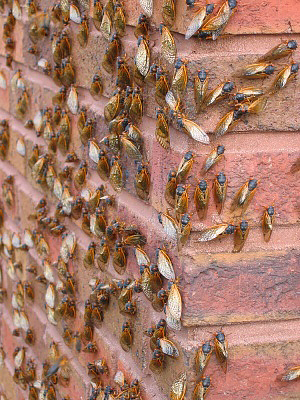
In the eastern United States, there are periodical (as well as annual) cicadas and they share a biological strategy, namely to occur in such large numbers that their predators can scarcely make a dent. Oak trees and beech trees do the same thing: in certain so-called “mast” years, they drop a staggering amount of fruits (acorns in the case of oaks). The animals that feed on their seeds eat their fill but plenty are left over to become the next generation of oaks or beeches.
The passenger pigeon used to follow this strategy too. Passenger pigeons occurred in the eastern United States in enormous flocks, perhaps in the billions (explaining why “pigeon” is a part of so many place names in states like Kentucky). John James Audubon described their flights as darkening the skies for a day or more. Their nesting sites were unpredictable from year to year, so they more than saturated any predator pressure wherever they did happen to nest in any particular year. That worked splendidly until there was a predator with railroads and a telegraph: as a consequence, hunters could descend in vast numbers on a nesting colony and ship carloads of pigeons off to city markets where they sold for a penny a piece.
It didn’t take long for the passenger pigeon to be driven to extinction. The last one, Martha, died in the Cincinnati Zoo in 1914. Aldo Leopold stated no “book pigeon” could replace what was lost. Indeed, it is hard to imagine the pigeon that Audubon, Washington, or Daniel Boone experienced.
Maybe because people are less inclined to eat cicadas, the periodical cicadas do survive and they are just starting to emerge this spring. There are two main kinds: one which appears every 13 years and one that does so every 17 years. They have been well mapped by scientists over the years, so we have known for a long time that “Brood II” of the 17-year cicadas was due this May. Such cycle lengths might seem odd but they are quite meaningful: they are prime numbers that are large enough that no predator can build up a population that would make a serious dent in cicada reproductive success.
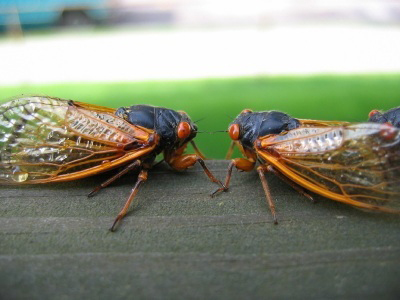
Soon the adult cicadas will start emerging from underground in the millions, sitting still for their first hour as their exoskeletons dry and harden. Soon after, they begin flying around, almost like some kind of clumsy space creature with red eyes. That suffices, because their only business in a few short weeks is to find a mate, and for the female to lay the fertilized eggs in a small slit she makes near the end of a tree branch. While this is in process, they will be emitting their loud buzz to attract one another. Some people object to the noise though I find most restaurants are a lot noisier.
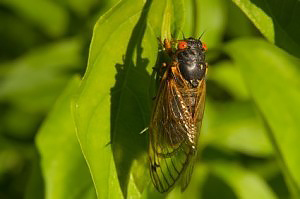
Cicadas are about as harmless an insect as one can imagine. They don’t feed or bite as adults; they simply live off the energy they have acquired during their seventeen subterranean years when they are feeding on juices from plant roots. Sometimes it looks as if trees have been pruned when the bit of branch extending beyond the egg deposit wilts and drops off. As numerous as cicadas can be, they never substantially damage a tree.
And as suddenly and as spectacularly as it started, it will be over. Quiet will return and the cycle will continue underground — in the case of “Brood II,” until May 2030. So rather than react in horror to what media in Washington have been calling “cicadagedon,” we really should revel in the wonder of it all. And, of course, it is fine if your dog indulges in cicadas. Cicadas are in fact quite nutritious, but like everything else it is possible to overdo.
Remembrance by Jim Currie, Class of ’64
January 14, 2022
Tom graduated from Millbrook a year ahead of me, but I had numerous occasions to rub elbows with him at our smallish boarding school (1956-59). The Millbrook Zoo attracted both of us to the school, and Tom was very close to its founder Frank Trevor. Trevor taught both of us biology.
Tom and another chap named Egbert Leigh were two of the most brilliant students Trevor ever had. I worked with Tom at the Zoo and would see him again at school gatherings over the years. He was a big fan of Millbrook and its founding Headmaster Edward Pulling, as was I.
I did not run across Tom too much during our years at Yale, but always liked him. His passing from pancreatic comes as a shock. I am very sorry I'll not have the opportunity to give him at least one more friendly hello.
Essay, 50th Yale Reunion Class Book
by Tom Lovejoy, Class of 1964
May 2014
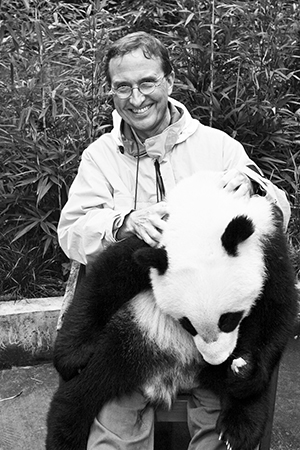
I arrived at Yale already passionate about biology and what has become known as biological diversity, a term I was the first to use. I went on to do a Ph.D. in ecology about Amazon birds. I remain involved in Amazon science and conservation to this day and basically planned to have a life of scientific expeditions and adventures.
In 1973 I had a chance to go to work for the World Wildlife Fund - U.S., in charge of its small program. I was employee number 13. I planned to go for two years and then resume the adventure track, but instead stayed 14 years. During those years I came to w1derstand the ever-growing importance of conservation and conservation biology.
In graduate school I married Charlotte "Mopsy" Seymour, daughter of History of Art Professor Charles Seymour, Jr. We had three daughters. That marriage ended in 1975 but we later became good friends and do many family things together. My three daughters have all ended up in the Washington area so I am fortunate to have frequent time with them and the five granddaughters.
In 1987 I went to the Smithsonian as assistant secretary for external affairs. The Congress soon realized there was someone at the Smithsonian knowledgeable about environment, so I became mud1 more involved at the interface of science and policy. I remain so to this day, often at the international level.
I left the Smithsonian in 1999, spent three years as chief biodiversity ad visor to the president of the World Bank and then became president of the Hei112 Center for Science, Economics and the Environment in 2002. I stepped down in 2008 and became biodiversity chair. In 2010 I became university professor of Environmental Science and Policy at George Mason Univ. and maintained the biodiversity chair title at the Heinz Center.
In 1985 I became interested in the interaction between climate change and the biology of the planet. I have co-edited two books on the subject and am currently starting a second edition of the more recent one.
So professionally I have seen environment and sustainability become a huge and essential agenda for society. And I can' t help but think about what kind of world my granddaughters will have to live in.

